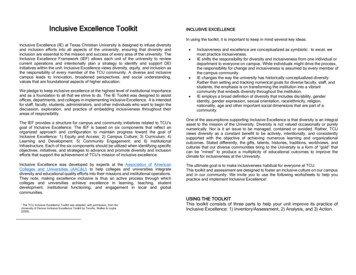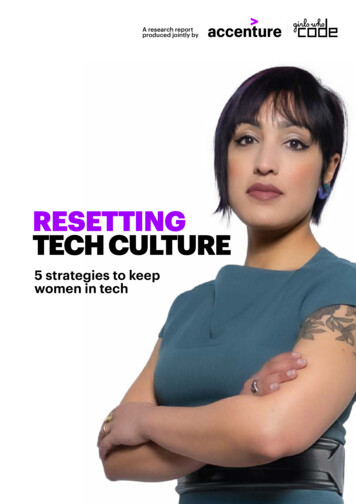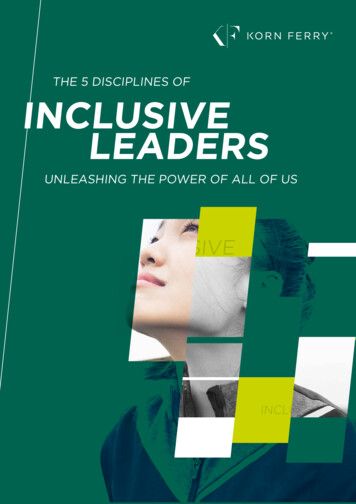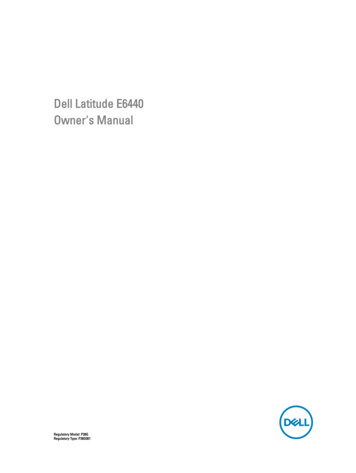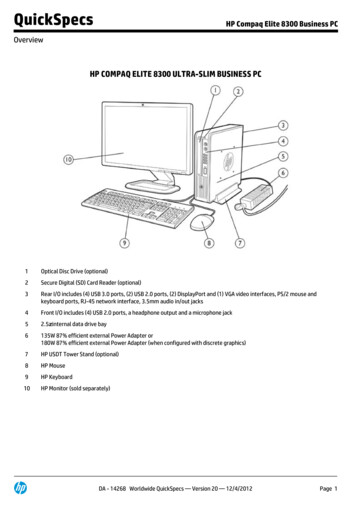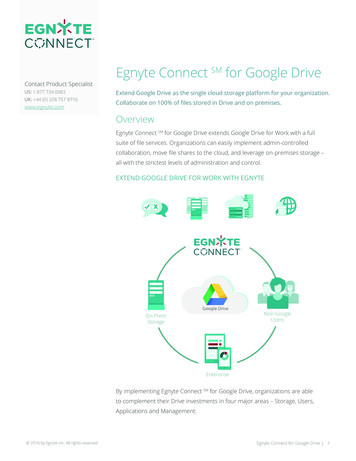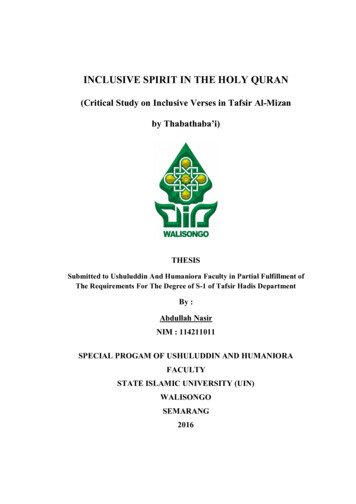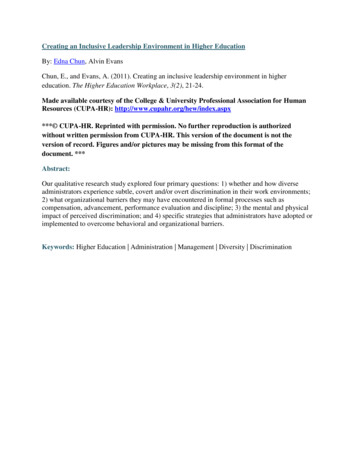
Transcription
HOW BUSINESS CAN DRIVE INCLUSIVE GROWTH ANDDEVELOPMENT:THE CASE OF EMPOWERING TRADITIONAL RETAILERSSeptember 9, 2015Authors:Beth Jenkins, Business Fights PovertyCatalina Garcia, SABMiller Latin AmericaElfid Torres, FUNDES International1
Executive SummaryInclusive growth, economic growth that increases opportunities and standards of living for all,stands to benefit a wide range of stakeholders. For business, inclusive growth promises to expandthe talent pool, stabilize and diversify the supply chain, strengthen the distribution chain, andgrow markets and revenues, as well as enable companies to deliver on social commitments atscale.Just as business is the engine of economic growth, so too must it be the engine of inclusivegrowth. And one way business can drive inclusive growth and development is to empower thetraditional trade.The traditional trade includes the mom-and-pop shops, corner stores, kiosks, open market stallsand street carts or hawkers that dominate the retail market in many developing countries, sellingfood and beverages, white goods, mobile phone airtime, pharmaceuticals, building materials,auto parts, furniture, and even some services such as hairdressing. In many ways, the traditionaltrade is the ideal channel for serving low-income communities in hard-to-reach urban slums andrural areas. At the same time, traditional retailers face many challenges.Empowering traditional retailers increases their incomes, protects them from financial risk,enables them to provide better nutrition, health care, and education for their children, andexpands access to valued products and services in their communities. It generates revenues forthe companies that serve them, reduces dependence on the state, and broadens the tax base.Empowering traditional retailers involves two distinct and mutually reinforcing activities:1. Training them as business owners, heads of household, and potentially even agents ofchange in their communities, and2. Strengthening the business ecosystems in which they operate—building links with arange of companies, financial institutions, government agencies, academia, and otherstakeholders that can offer productivity-enhancing and revenue-generating products andservices to buy and sell, and an enabling policy and regulatory environment in which tooperate.SABMiller, The Coca-Cola Company, PepsiCo, Visa, Cemex, Intel, Qualcomm, Nestlé,Millicom and numerous local companies are already beginning to take this kind of holisticapproach. And there is considerable scope to replicate and scale their efforts.We have learned four key lessons about how to succeed at scale:1. Focus first (and always) on increasing outlet sales2. Segment and engage outlets according to their incentives and capabilities2
3. Share costs with other companies that stand to benefit financially4. Use corporate social investment and government or donor funding to fill in gaps1. A Vision for Inclusive Growth and DevelopmentAround the world, visionary leaders in business, government, the donor community, and civilsociety are beginning to imagine a new model of growth and development.They imagine a world in which all people have access to opportunity, not just charity.Opportunity to find meaningful work and move forward in their careers. Opportunity to use theirown earned income to invest in their own lives and families—nutritious food, clean water,improved sanitation, healthcare, energy, information and communications technology, and evennon-essential and non-productive purchases that they nevertheless have reason to value.Opportunity to live lives of dignity and possibility, and to pass even greater opportunity on totheir children.Such a world would be full of benefits. For the billions of people who live in poverty, possibly as many as a billion women whoare not working but might like to, the hundreds of millions of youth neither working norstudying,1 such a world would offer a step change in standards of living and personalfulfillment.For businesses, such a world would offer a bigger, better labor force, more stable supplychains, more sophisticated distribution networks, and growing markets.For governments, such a world would offer greater social stability, peace and security,reduced dependence on the state, broader tax bases, and increased capacity to investstrategically for the future.For donors and civil society organizations, such a world would—at least in manyrespects2—represent a mission accomplished.What these leaders are imagining is inclusive growth.This is not just economic growth, which for too long, has left billions of people by the waysideand widened the gap between rich and poor. Inclusive growth is economic growth that expandsopportunities and improves standards of living for all. According to the International MonetaryFund, inclusive growth is also more sustainable and leads to greater gains over time.31Numbers from The World Bank. 2012. “Overview: World Development Report 2013: Jobs.” Washington, DC: TheInternational Bank for Reconstruction and Development.2For example, the environmental implications of inclusive growth require careful consideration and urgent action.3Berg, Andrew G. and Jonathan D. Ostry. 2011. “Inequality and Unsustainable Growth: Two Sides of the SameCoin?” IMF Staff Discussion Note SDN/11/08. Washington, DC: International Monetary Fund.3
Business is the engine of economic growth, and must be the engine of inclusive growth as well.Business supports the vast majority of jobs and makes available the vast majority of products andservices people need to live healthy, productive, and satisfying lives. And if business activity—investing, procuring, manufacturing, distributing, selling, marketing—can be harnessed todeliver these benefits for all, it would benefit business as well. Business only prospers to theextent that others in its ecosystem also prosper. And as described above, inclusive growthpromises to expand the talent pool, stabilize and diversify the supply chain, strengthen thedistribution chain, and grow markets and revenues, as well as enable companies to deliver ontheir social commitments at scale.2. The Distribution ProblemFor leaders imagining a new model of inclusive growth and the shared benefits it offers, the keyquestion is how to provide the many types and layers of opportunity on which it depends to thebillions of people who need it. How do business, government, the donor community, and civilsociety go about delivering access to quality education and skills training, nutritious food, cleanwater, improved sanitation, affordable healthcare, energy, and technology, and decent jobs andother income generating opportunities to all the people who currently lack them?A first principle is that people must want, not just need, what is offered. Products, services, andincome generating opportunities must be appropriate and even aspirational for people to adoptand stick with them, even when they are provided for free.4When this principle is observed, distribution becomes the major bottleneck.People who lack opportunity may live in far-flung rural villages or in densely populated urbanslums with poor transport infrastructure, which are physically hard to reach. While cell phonesare becoming ubiquitous, they may not have Internet access. People who lack opportunity maydo so because their education and skill levels are low. They may have low and unpredictableincomes, limited access to financial services, and very little ability to take even well-calculatedrisks. While many have valuable social support systems, their networks do not often extend tohigh places. Their trust in existing institutions and systems, which are not working for them, isunderstandably low. And those institutions and systems typically have insufficient informationabout their needs, capabilities, and aspirations.In such circumstances, the cost of expanding opportunity can keep aid-based programs small inscale and prevent business models from taking off at all.There are two parts of the distribution problem:4See, inter alia, Karamchandani, Ashish, Mike Kubzansky, and Nishant Lalwani. 2011. “Is the Bottom of thePyramid Really for You?” Harvard Business Review. Online at the-pyramid-really-for-you (accessed July 30, 2015).4
Reach: The first part of the distribution problem is the cost of physically reaching targetgroups to deliver products and services and to create or support income generatingopportunities. Conversion: The second part of the distribution problem is the cost of enabling people toavail themselves of what is being offered once it is there—for example by buildingrelationships of trust, providing consumer education, facilitating access to technology orfinancing, and more, depending on the context and the product, service, or incomegenerating opportunity being offered.3. The Traditional Trade SolutionAcknowledging that the present situation is far from perfect, it is worth asking how people wewould consider lacking in opportunity obtain products, services, and incomes now.To take just one segment that is lacking in opportunity—but a very large one, at 4.5 billionpeople—the World Bank reports that low-income people in developing countries currently spend 2.3 trillion on food and beverages, 508 billion on housing, 405 billion on clothing, footwear,and personal care, 243 billion on healthcare products and services, and 206 billion oninformation and communications technology.5Detailed information on where these people spend their money is not available, but we know thatin many developing countries, the traditional trade continues to dominate over more modernforms of retail, and is expected to do so “for the foreseeable future.” 6 The term “traditionaltrade” refers to the mom-and-pop shops, corner stores, kiosks, open market stalls and streetcarts or hawkers that sell products such as food and beverages, white goods, mobile phoneairtime, pharmaceuticals, building materials, auto parts, furniture, and even services such ashairdressing. Traditional retailers in Latin America can account for up to 50% of sales for someconsumer goods companies.7 In Colombia, they account for about 60% of food sales 8 and in5World Bank data summarized in International Finance Corporation (IFC). No date. “Global Consumption Data forInclusive Business.” Online 3e1a906b9869243d457/IFC IncluBus Brochure May 6.pdf?MOD AJPERES (accessed July 27, 2015).6Bain & Company. 2011. “Consumer Products & Retail: Are You Ahead of the Curve in Emerging Markets?” BainIndustry Brief. Online athttp://www.bain.com/Images/INDUSTRY BRIEF Ahead of curve in emerging markets.pdf (accessedSeptember 2, 2014).7Multilateral Investment Fund (MIF) of the Inter-American Development Bank (IDB). 2014. “Improvingcommunities in six Latin American countries through the leadership of shopkeepers.” Project Abstract for ProjectNumber RG-M1241. Washington, DC: IDB.8Costa, Leticia and Fernando Fernandes. 2006. “Successful Retail Innovation in Emerging Markets” LatinAmerican Companies Translate Smart Ideas into Profitable Businesses.” Booz&Co for the Coca-Cola Retailing5
Indonesia, they account for upwards of 80%. 9 In India, the traditional trade is estimated toaccount for more than 90% of all retail sales.10Why is the traditional trade such a powerful channel?Advantages of the Traditional Trade1. Reach: While data are limited, we know that there are millions of such outlets indeveloping and emerging markets worldwide. In Mexico, for example, there are morethan two million of them—nearly 50% of all micro-enterprises.11 If a similar percentageapplies, there may be as many as 14 or 15 million traditional retailers across LatinAmerica (unfortunately, data are not available for all countries). 12 These outlets arelocated close to their customers, in urban and rural areas that are often hard to reach.Customers with low and variable incomes, limited transportation, and no storage space athome rely on these outlets to meet their daily needs, visiting frequently to purchase insmall quantities as their cash flows allow.2. Demographics: Low-income people, many of them women, own and/or operate many ofthese outlets; this makes the traditional trade a key source of employment and income formillions of people lacking better alternatives, and a key source of nutrition, healthcare,education, and other benefits for their families. Studies have shown that women are morelikely to spend their money in ways that benefit their children.133. Relationships: Traditional retailers play special roles in their communities and tend to betrusted figures and reference points. They also get to know their customers well. As aresult, they can allow customers to purchase on credit when times are particularly tightand reasonably expect to be repaid—customers are their neighbors and friends, and for allthe reasons mentioned above, they want to be able to come back to these stores.Research Council. Online sfulRetailInnovationinEmergingMarkets.pdf (accessedNovember 11, 2014). Page 3.9Bain & Company study cited in Grazella, Mariel. 2013. “Traditional trade to dominate retail over next 15 years:Study.” The Jakarta Post, December 13. Online at udy.html (accessed July 27, 2015).10Banerjee, Rajiv. 2006. “Traditional Trade Channels Still a Draw for Retail Biggies.” The Economic Times ofIndia, October 26. Online at 10-26/news/27448708 1 daburfoods-trade-channels-outlets (accessed July 27, 2015).11Instituto Nacional de Estadística y Geografía. “Directorio Nacional de Unidades Económicas.” Online ault.aspx (accessed July 31, 2015).12Extrapolation by FUNDES.13The World Bank. 2012. “2012 World Development Report: Gender Equality and Development.” Washington,DC: The International Bank for Reconstruction and Development/The World Bank. Page 5.6
For these reasons, experts such as the International Finance Corporation 14 (IFC) and theconsultancy Monitor 15 (recently acquired by Deloitte) recognize the traditional trade as apromising channel for reaching low-income populations with products and services with thepotential to improve economic opportunities and standards of living.At the same time, these and other experts, as well as numerous companies, social enterprises, anddevelopment agencies working on the ground, recognize that the traditional trade faces a rangeof interconnected challenges that must be overcome to realize its full potential. It is clear that tomaximize inclusive growth and development impact, products and services provided throughtraditional trade channels must include offerings that help outlets themselves to overcome thesechallenges.Challenges of the Traditional Trade1. Size: Outlets are numerous and small, often with working capital and storage space forjust a few days’ inventory. This limits their ability to negotiate with suppliers for betterprices or payment terms, and requires suppliers to make frequent deliveries of smallquantities of product. Outlets also face stiff competition from one another, and from“bigger box” retail formats that are beginning to take hold.2. Skills: While traditional retailers often have quite a bit of innate business sense, few havetraining in skills such as inventory management, accounting, marketing and sales thatwould help them optimize their performance, and therefore their incomes and the optionsand opportunities they are able to offer their families and communities.3. Financial insecurity: Because their customers have low and unpredictable incomes,outlet revenues can be low and unpredictable as well. Combined with limited access tofinancial services, this makes it difficult to invest in technology, equipment, and otherassets that could, over time, reduce operating costs and increase revenues.4. Informality: Many outlets prefer to remain informal (that is, unregistered and/orunlicensed) in order to reduce certain costs, but informality comes with its own costs andrisks, such as higher cost of credit from informal lenders and lack of access to socialsecurity programs.14International Finance Corporation (IFC). 2014. “Shared Prosperity through Inclusive Business: How SuccessfulCompanies Reach the Base of the Pyramid.” Online 1548c90bd9916182e35/SharedProsperitythruiBiz FINAL.pdf?MOD AJPERES (accessed July 28, 2015). Page 27.15Kubzansky, Mike, Ansulie Cooper, and Victoria Barbary. 2011. “Promise and Progress: Market-Based Solutionsto Poverty in Africa.” Online at gress-MIM.pdf (accessed July28, 2015). Page 65.7
5. Access to finance and technology tools: Many traditional retailers have low levels offinancial literacy, do not understand how formal financial services could help them, andtend to mistrust the banking sector. In addition, banks offer few appropriate products andservices. As a result, they often stick with the microfinance sector and informal lenders,and tend to use only cash, adding to suppliers’ transaction costs.4. Empowering the Traditional Trade to Drive Inclusive Growth and DevelopmentThe idea of distributing products, services, and income generating opportunities through thetraditional trade is not new. What is new is our knowledge of how to do it, and do it in a way thatmaximizes inclusive growth and development impact with benefits for all stakeholders.FoundationsWe are starting from the premise that large national and multinational companies will play amajor role, given their existing networks and relationships, their understanding of complex routeto-market dynamics, and their distribution, sales, and marketing expertise. In a large study ofmarket-based solutions to poverty in Africa, Monitor found that such companies “were the maindrivers of successful efforts [to distribute products and services through the traditional trade];this was so whether led by mobile operators, agri input providers, [consumer packaged goods]companies, health product distributors, or others.” 16 In addition, many governments anddevelopment organizations consider linkages with large companies to be critical aspects of smallbusiness support. For traditional trade outlets, those linkages provide access to products thatconsumers want, with brand names they trust, large-scale consumer marketing behind them,professional customer service, and—often a range of support services designed to help outletsincrease their sales.Support services designed to help traditional retailers increase their sales are fairly common, atleast among product manufacturers or service providers with sufficiently high margins to coverthe cost.For example, SABMiller, one of the world’s leading brewers, provides consumer marketing (e.g.radio, television, and print advertising) and merchandising support (e.g. signage, brandeddisplays and other assets), funds minor store upgrades such as painting, and often allows outletsto purchase on credit. 17 Unilever, a leading consumer goods company, has begun to provideoutlets without electricity with solar lanterns that allow them to stay open later, increasing their16Kubzansky et al 2011, page 67.Jenkins, Beth. 2015. “Empowering Small Businesses in Corporate Value Chains: The Case of SABMiller’s 4eCamino al Progreso Program.” Cambridge, MA: CSR Initiative at the Harvard Kennedy School and Business FightsPoverty.178
sales significantly. 18 In many urban environments in the developing world, The Coca-ColaCompany has implemented an entirely new distribution model geared toward traditional tradeoutlets, using Micro Distribution Centers run by independent entrepreneurs to provide frequent,small deliveries that would be uneconomical for larger distributors to make, using pushcarts,motorcycles, small vans, or other manual or motorized means depending on the circumstances. 19Many such companies also provide product- and industry-specific training and, sometimes,broader business skills training to help traditional retailers increase their sales. According to IFC,training has been provided successfully through in-store coaching, classroom training and elearning by company employees, training companies, and even civil society organizations.20For example, to drive sales of its small packs of pesticides among small-scale farmers in Kenya,Bayer CropScience trained small, rural agrodealers to serve as “GreenWorld consultancycenters” that advise farmers on product use. According to Monitor, these agrodealers haveincreased their incomes by approximately 40% and facilitated adoption of a productivityenhancing agricultural input among their customers.21In another example, when Safaricom launched its M-Pesa mobile money transfer service, also inKenya, it had very limited interactions with the traditional trade outlets that sold its airtime. Thecompany had to train these outlets in a new set of skills, such as managing their cash “float” inorder to maintain enough “cash in” to be able to accommodate customers’ requests to “cash out”the money in their mobile wallets on demand. Safaricom contracted Top Image, a firm thatspecializes in advertising and field force management, to do this cost-effectively forapproximately 17,000 outlets.22 M-Pesa now serves more than 18 million users in Kenya andTanzania and moves billions of dollars every month.23The Next FrontierFrom an inclusive growth and development perspective, efforts like those described above arecommendable because they enable traditional trade outlets to increase their sales and incomes,strengthen their financial positions, provide better standards of living for their families and futureopportunities for their children, and offer a broader range of product and service choices to18Acumen and Business Fights Poverty. Forthcoming (October 2015). “Social Enterprises and Global Corporations:Collaborating for Growth with Impact.” New York, NY: Acumen Fund.19IFC. 2010. “Coca-Cola SABCO.” IFC Inclusive Business Case Study. Online e078958cdf81ee631cc/Coca-Cola.pdf?MOD AJPERES(accessed July 28, 2015).20IFC 2014, page 28.21Kubzansky et al 2011, page 69.22Karamchandani et al 2011.23Mannak, Miriam. 2015. “Can Mobile Money Conquer New Markets?” MIT Technology Review. Online mobile-money-conquer-new-markets/ (accessed July 29,2015).9
consumers at prices they can afford. We hope to see them replicated to the fullest extent possibleby other companies that can afford it (i.e., for whom the financial returns exceed the costs).At the same time, such examples have revealed the potential to do more.Today, a number of leading companies have begun working to strengthen and align the broaderbusiness ecosystems in which their traditional trade networks are embedded, and to train retailersas business owners, heads of household, and even agents of change in their communities. Strengthening business ecosystems: These leading companies recognize that while theirbusiness practices matter, and while they can provide some valuable support services ontheir own, traditional retailers will only reach their full potential if they are embedded insupportive “business ecosystems” that go beyond individual company value chains.The CSR Initiative at the Harvard Kennedy School and Business Fights Poverty haveexplained that “the term ‘ecosystem’ comes from ecology, where it refers to a communityof organisms that depend on one another and a shared natural environment. StrategistJames Moore coined the term ‘business ecosystem’ in a McKinsey Award-winningHarvard Business Review article in 1993, noting that firms, too, depend on communitiesof interconnected, interdependent stakeholders, including suppliers, distributors, retailers,customers, companies selling complementary products, competitors, investors, tradeassociations, regulators, and others.” They note that small businesses such as traditionalretailers “flourish when suppliers offer the right products and services at affordableprices, with payment and delivery terms that suit their cash flows; when banks offerappropriate payment, investment, and risk management services; when educationalinstitutions equip them and their employees with the knowledge and skills they need tosucceed; when government provides an enabling regulatory and tax environment and putsrelevant infrastructure and public services in place.”24 Training retailers as business owners, heads of household, and even agents ofchange in their communities: Leading companies have observed that product- andindustry-specific training only goes so far, and that retailers also require broader businessskills training. Leading companies have also observed that traditional retailers’businesses are nearly inseparable from their family lives and closely tied to theircommunity dynamics. As a result, they are beginning to incorporate life skills and lifeplanning – and in one case, even experimenting with supporting traditional retailers tospearhead modest community development projects in their neighborhoods. This case,24Jenkins, Beth, Richard Gilbert, and Piya Baptista. 2014. “Sustaining and Scaling the Impact of EnterpriseDevelopment Programmes: SABMiller’s Approach to Strengthening Business Ecosystems.” Cambridge, MA: CSRInitiative at the Harvard Kennedy School and Business Fights Poverty.10
SABMiller Latin America’s 4e Camino al Progreso program, is described in more detaillater in this paper.As the CSR Initiative and Business Fights Poverty put it in a report on the 4e program,“many of [traditional retailers’] shops are in their homes; their relatives help runoperations; and their customers are their neighbors and friends.” The authors note thatempowering retailers as business owners, heads of household, and community members“has the potential to unleash a virtuous cycle rooted in, but going beyond, improvedbusiness performance. If a retailer’s business performs better, it generates more income,which can be used to improve the retailer’s family’s standards of living and create betteropportunities for younger generations. This, in turn, improves the retailer’s self-esteemand frees up time and attention to play a greater role in the community. Strengtheningcommunities helps build better customers, and increases the retailer’s visibility andreputation—attracting more people to the store, further improving business performance,and reinforcing the cycle.”25Strengthening retailers’ business ecosystems and training them as business owners, heads ofhousehold, and potentially even agents of change in their communities can catalyze a range ofbenefits for retailers, their families and communities; for the large and small companies thatsupply them; and for governments and society at large. These benefits are depicted in the figurebelow.Section 5 provides a detailed example of this “next frontier” approach. Section 6 providesadditional examples and lessons learned about what is necessary for this approach to succeed atscale.25Jenkins 2014, page 25.11
Figure 1. Benefits of Empowering the Traditional Trade to Drive Inclusive Growth andDevelopment5. Case Study: SABMiller’s 4e Camino al Progreso Program26Background and DriversFounded in South Africa in 1895, SABMiller is now one of the world’s largest brewers, with70,000 employees and operations in more than 80 countries on six continents. It is also one ofthe world’s largest bottlers of Coca-Cola products and its own soft drinks. Latin America andAfrica are two of the company’s fastest-growing markets.In Latin America, SABMiller is the market leader in Colombia, Perú, Ecuador, Panamá,Honduras, and El Salvador, where its subsidiaries are local companies with operating histories inthe range of 100 years. Across these countries, the traditional trade is a vital channel, with small26Adapted and updated from Jenkins, Beth. 2015. “Empowering Small Businesses in Corporate Value Chains: TheCase of SABMiller’s 4e Camino al Progreso Program.” Cambridge, MA: CSR Initiative at the Harvard KennedySchool and Business Fights Poverty.12
scale retailers representing approximately 40% of the company’s total sales volume. The figureis even higher in some countries, such as Colombia, where it is close to 60%.For many years, SABMiller’s local subsidiaries have supported these retailers through help withmarketing, merchandising, acquiring assets and equipment, such as refrigerators, and makingmodest store upgrades, such as painting. Some assist further by allowing customers to purchaseon credit. More recently, subsidiaries in a number of the countries have launched corporate socialinvestment programs intended to offer support in even more fundamental ways, like providingbusiness skills training and facilitating access to financing.In 2012, with support from Fundación DIS, a nonprofit consulting firm serving companies andsocial enterprises, SABMiller Latin America and its subsidiaries decided to consolidate,strengthen, and scale a consistent regional approach to supporting the small retailers and broadercommunities on which such a significant share of its sales depend: the 4e Camino al Progresoprogram. For this, they joined forces with FUNDES, a civil society organization that works tobolster the competitiveness of micro, small, and medium enterprises in Latin America in order toimprove livelihoods and create jobs.With offices in Argentina, Bolivia, Chile, Colombia, Costa Rica, Guatemala, El Salvador,Mexico, Panamá, Perú, and Venezuela and a presence in several other countries, FUNDES nowmanages approximately 100 projects each year. Its staff provide business analysis, tr
Traditional retailers in Latin America can account for up to 50% of sales for some consumer goods companies.7 In Colombia, they account for about 60% of food sales8 and in 5 World Bank data summarized in International Finance Corporation (IFC). No date. "Global Consumption Data for Inclusive Business." Online at

